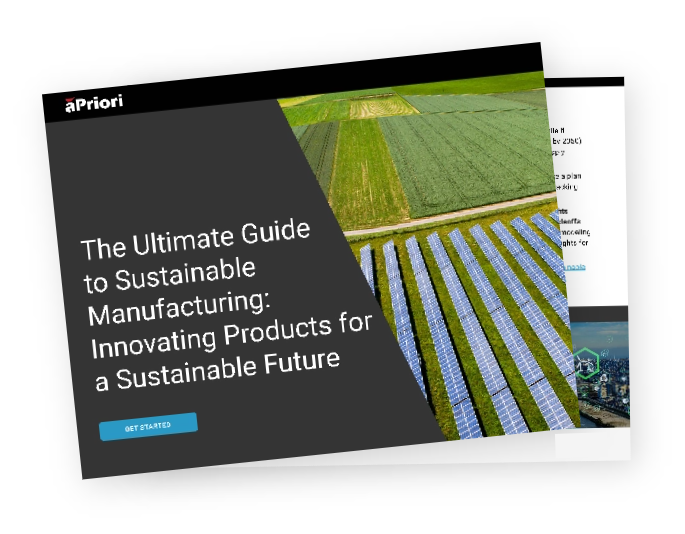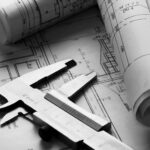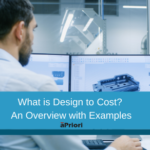
Key Takeaways:
- EU automakers face stringent environmental regulations, driving a need for immediate climate action to reduce greenhouse gas emissions (GHG emissions) and meet carbon net-zero targets
- Automakers can make sustainable and cost-effective business decisions by using strategies like lightweighting and digital tools
The Full Article:
The European Union (EU) has mandated that all new vehicles sold within its member states must have zero tailpipe emissions starting in 2035. This mandate has led to a significant shift toward electric vehicles (EVs). Luca de Meo, CEO of Renault Group, believes that this transition to EVs is the “most profound change” the sector has experienced in the past 150 years.
Phasing out fossil fuel-powered cars for EVs is a crucial step toward a green future. However, to achieve carbon net zero, automakers need to look beyond tailpipe emissions. The emissions from raw materials during cradle-to-gate manufacturing are complex and significant after electrification.
Acknowledging these electrification challenges is essential, but so is understanding that prioritizing the environment presents a considerable business opportunity. EU automakers that adopt sustainable practices are more likely to meet stakeholder expectations and improve profit margins.
So, the question remains: how can automakers not only stay competitive but also outmaneuver their industry competitors in achieving business excellence? This question leads us to explore six strategic approaches to carbon emissions reduction that EU auto manufacturers can employ.
How an Internal Combustion Engine (ICE) Ban Impacts European Automakers
The EU’s move to become the first climate-neutral continent is putting pressure on European automakers to increase EV production. However, Chinese automakers produce 75% of the world’s batteries in-house, while European manufacturers depend on dual external supply chains for electric (and fossil-fuel) resources.
Chinese automakers’ vertical integration has enabled them to cut costs and provide affordable, low-carbon footprint vehicles to consumers more quickly. According to EU customs data, China’s shipments of EVs to the Union have increased by 361% since 2021. One factor contributing to this growth and success is that Chinese-made EVs are selling at a 20% lower price compared to those manufactured in the EU.
To remain competitive and meet the EU’s climate goals, European automakers can adopt various strategies to achieve net-zero carbon emissions and outperform their market rivals.
Strategies for EU Automakers to Surpass Rivals and Achieve Net-Zero Emissions
The shift toward electrification is progressing, enabling EU automakers to propel their decarbonization efforts and reduce carbon dioxide equivalent (CO2e) emissions by 73% by 2050.
However, assessing the embodied carbon from cradle-to-gate for both EVs and ICE cars is more complex than evaluating in-use and end-of-life emissions, which are based on assumptions. This complexity, resulting in increased expenses, arises due to the multiple inputs and variables involved in the production process. To address this issue, EU automakers should consider the following six factors:
- Lightweighting
- New Processes
- Circularity
- Design Collaboration
- Sustainable Sourcing
- Digital Transformation and Automation
1) Lightweighting
Reducing weight is crucial for battery electric vehicles (BEVs) to reach the range offered by fossil fuel-powered cars. Manufacturers can achieve this by using more exotic and stronger lightweight materials, but this can be expensive. Therefore, it is necessary to assess the cost implications of such materials in the early stages of product development.
Another way automakers can produce lightweight parts and minimize material utilization is through additive manufacturing. However, it is important to note that this manufacturing process may be more energy-intensive and expensive, especially for high volumes. Depending on the production process, lightweight designs may also lead to increased costs from more complex tooling or longer, more time-consuming processing. That is why early data-driven decision-making is critical.
2) New Processes
Leading automakers like Tesla, Volkswagen (VW), and Volvo are employing gigacasting—a large-scale, high-pressure die-casting (HPDC) approach—to consolidate parts. By embracing such a process, EU manufacturers can reduce assembly costs and efficiently produce lightweight vehicles.
However, creating a new vehicle architecture comes with significant risks. If the design is not suitable for the manufacturing process, it may become too expensive or unfit for its intended purpose, resulting in costly redesigns for the entire project.
Dana Corporation, an innovator of light vehicle drive systems, shared an example of the costs incurred due to failed product development projects. The company states that if a manufacturing process or design concept is deemed too expensive during late-stage product development, the loss could be as high as $3 million. Therefore, it is crucial to estimate costs and design for manufacturability (DFM) during the early design stage for all components and assemblies.
Adopting a solution like aPriori provides this capability. aPriori’s real-time design guidance for cost, DFM, and sustainability empowers automakers to innovate quickly and confidently, making informed design decisions from the outset.
3) Circularity
The circular economy is a model for automakers to reuse, recycle, and repurpose materials/components to minimize waste and move toward becoming carbon neutral. The circularity model extends across the entire product life cycle, enabling project stakeholders to make sustainable decisions that offset negative climate impacts.
BMW exemplifies circularity in the automotive industry. The company follows a “secondary first” approach, using 30% recycled and reused materials in vehicle production. In the near term, the vehicle manufacturer intends to increase this percentage to 50%, further reducing its use of newly extracted materials.
However, circularity can also present significant challenges for EU automakers. For instance, companies need to find the perfect balance between using recycled materials and remaining cost-effective. Additionally, recycled materials may not be readily available for manufacturers to use in vehicle production. Automakers must also consider Design for Disassembly (DfD) principles, which allow for easy separation of vehicle components for efficient recycling. DfD is particularly essential for recovering valuable materials such as copper and steel.
To mitigate these challenges, automotive manufacturers are investing in solutions like aP Analytics to assess the risk of price fluctuations or material shortages by considering historical price trends and dynamic market conditions. Based on this manufacturing data, automakers can consider alternative recycled materials with lower costs and risks.
4) Design Collaboration
Collaboration between design engineers, sustainability experts (EcoDesign engineers), value engineers, and procurement can be an effective way to gain valuable insights into each department’s expertise. Unfortunately, these departments often work in silos and do not have access to the same systems. That is why having a shared platform with centralized data that allows in-context collaboration around product cost, carbon, and manufacturability is essential.
aPriori’s real-time collaboration tool, aP Workspace, brings siloed teams together to access unified product design and manufacturing data in one platform. With aP Workspace, internal stakeholders can connect and accelerate project management by making rapid, data-driven design decisions.
One of the most significant advantages of aP Workspace is that it is agnostic to computer-aided design (CAD) and product lifecycle management (PLM) systems. Further, aP Workspace automatically evaluates the geometry of 3D CAD models whenever they are checked into a PLM system, generating precise cost and carbon insights.
Learn more about aP Workspace’s real-time collaboration and task management capabilities.
5) Sustainable Sourcing
EU automakers have a responsibility to make sustainable and well-informed decisions when sourcing their components. This includes carefully evaluating different energy, factory, and material mixes across various regions. By doing so, they can explore the most sustainable and cost-effective sourcing options available to them. This not only benefits an automaker’s bottom line, but it also enables them to contribute to preserving the earth.
Moreover, evaluating sourcing options allows EU auto manufacturers to balance cost-efficiency with environmental impact. This involves making informed decisions on whether to produce parts in-house (“make”) or purchase (“buy”) components from external suppliers. Notably, suppliers offering lower costs tend to be located in regions with higher carbon footprints. This underscores the importance of carefully weighing make vs. buy decisions on the path toward carbon net zero.
To promote sustainability and level the playing field in the EV market, the EU introduced its Carbon Border Adjustment Mechanism (CBAM) tariff in 2023. CBAM imposes taxes on higher-polluting imports from non-EU countries that provide carbon-intensive materials, such as steel and aluminum. EU automakers also feel the impact of CBAM as they are encouraged to source from suppliers with lower carbon footprints and avoid certificate costs.
6) Digital Transformation and Automation
Automation-driven technology, such as aPriori’s Manufacturing Insights Platform, facilitates comprehensive evaluation of the cost, carbon footprint, and ease of manufacturing of designed components. This technology helps identify the most expensive and carbon-intensive parts simultaneously, enabling automakers to identify areas for improvement quickly.
By leveraging digital and automated software, automakers can also identify manufacturing challenges and assess volume distribution, material costs, and process utilization. As a result, EU auto manufacturers can discover new opportunities for innovation and cost-effective redesign.
Discover more about the power of aPriori’s automated Manufacturing Insights Platform.
Taking Effective Steps Toward Carbon Neutrality
The EU automobile industry faces a pivotal moment as it strives to navigate environmental mandates and achieve carbon neutrality. To meet carbon targets and stay ahead of competitors, automakers can use key strategies like lightweighting, circularity, sustainable sourcing, and digital transformation. By embracing these approaches, EU auto manufacturers can drive sustainable innovation and profitability in a dynamic market focused on achieving carbon net zero.
Innovate Your Products for a Sustainable Future!






